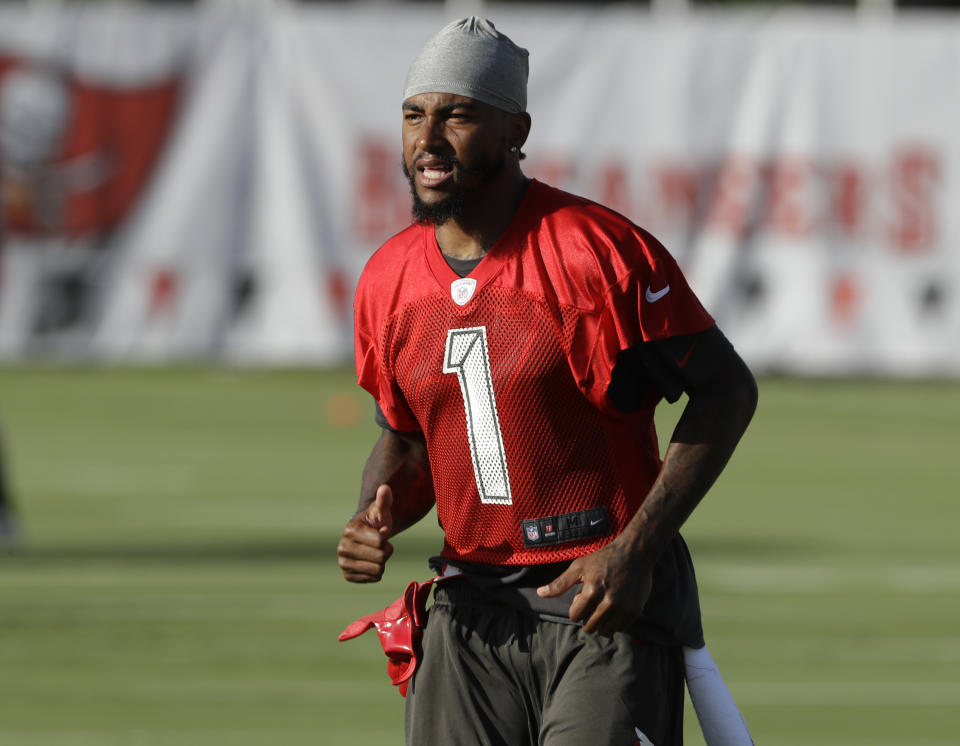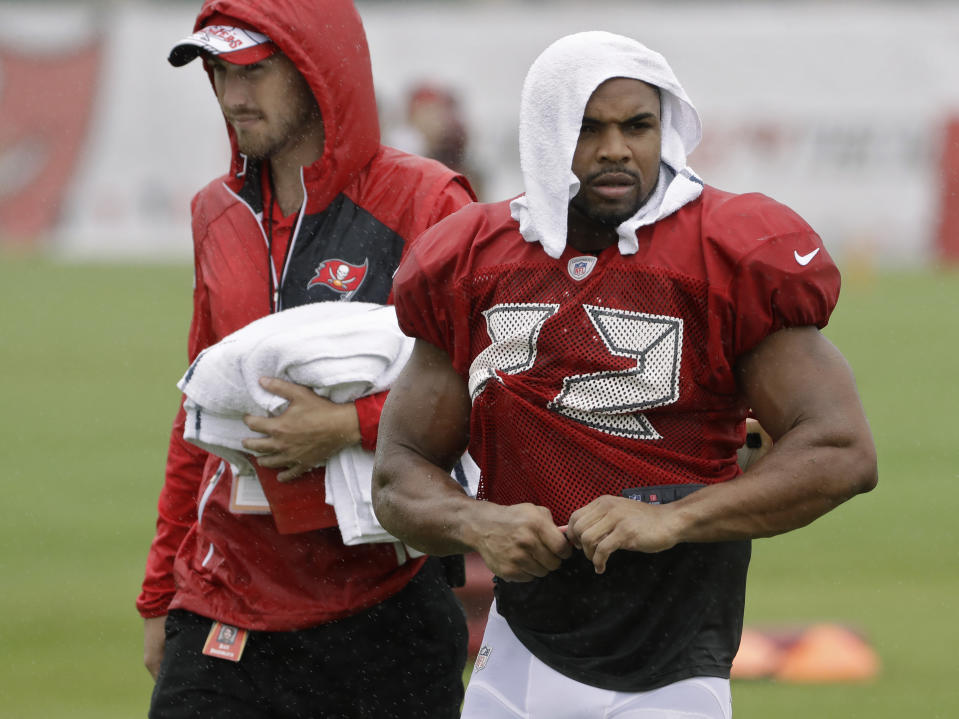Juggernaut Index, No. 9: Jameis Winston leads enhanced Bucs offense

One of quirks to traditional fantasy scoring is that we end up caring very little about a quarterback’s accuracy or his propensity to give away the football. In most scoring formats, the penalty for an interception is extremely modest, typically -1. It isn’t much more than a nuisance, really. This is how we end up with Blake Bortles finishing a season as a top-five fantasy QB — as he did in 2015 — despite completing less than 60 percent of his throws and leading the NFL in picks, fumbles and sacks.
[Now’s the time to sign up for Fantasy Football! Join for free]
In reality, turnovers often determine game outcomes. They are not small occurrences. The league’s best QBs consistently produce very low interception rates, 2.0 percent or less.
Jameis Winston is not yet such a quarterback. He threw 18 interceptions last year, 15 as a rookie and another 18 in his final collegiate season at Florida State. He’s completed just 59.6 percent of his passes in the NFL. He also put the ball on the ground 10 times last year. Winston isn’t where he needs to be in terms of accuracy, efficiency or precision.
But for fantasy purposes, this means next to nothing. Winston has already delivered back-to-back 4000-yard seasons, tossing 50 TD passes and rushing for another seven scores in 32 career games. Fantasy owners aren’t complaining about his turnover issues (because traditional fantasy scoring is broken); he puts points on the board and averages better than 250 yards per game.
Winston is also just 23 years old, we should note — younger than Carson Wentz and only a few months older than Mitch Trubisky. We clearly haven’t seen Winston’s best years. He entered the league with advanced skills, plenty of arm, ideal size and an ability to quickly process on-field events. There’s every reason to believe Winston will eventually lead deep postseason runs in Tampa. He certainly doesn’t suffer from an excess of caution. Winston finished among the NFL leaders in air yards per attempt (4.9) and deep ball attempts per game (5.4) last year, per Player Profiler. He wasn’t particularly accurate on deep throws (26.7 percent), but the effort is meaningful and appreciated.
Tampa Bay enhanced Winston’s supporting cast in a big way during the offseason, both in the draft and free agency, which has fantasy owners paying an expectant price. He’s the eighth quarterback selected in an average Yahoo draft (68.0), which means he’s going ahead of Big Ben, Cam, Cousins, Carr and Rivers. That’s a bit too rich for me. Still, it’s easy to understand the crowd’s enthusiasm for an ascending QB with an improved receiving corps at his disposal.
Mike Evans and D-Jax are an excellent tandem.
Evans and Jackson may not be the league’s best receiving duo, but we can’t have the conversation without mentioning them. It’s a fun pairing. Jackson is simply one of the best deep-strike receivers of any era, and he’s coming off his fifth 1000-yard season. He led the league in yards per reception in two of the past three years. D-Jax turns 31 in December, but he still has rare deep speed. It feels as if Jackson is perpetually injured, yet he’s appeared in 15 or more games in three of the past four seasons. Stylistically, he’s an ideal complement to Mike Evans, a 6-foot-5 target magnet. Jackson doesn’t need a massive target share in order to produce useful fantasy totals; three times in his career he’s topped 1000 receiving yards on fewer than 60 catches.

Evans is obviously one of the league’s most challenging coverage assignments. He’s built like a plus-sized tight end, yet he has a receiver’s speed, leaping ability and separation skills. Evans’ targets, receptions and yardage have increased each season since he entered the league, and he just turned 24. His 175 targets led the NFL last year, and his 12 receiving TDs tied for second. It’s worth noting, however, that his workload dipped a bit in the second half of 2016; he saw 103 targets in the first eight games and 72 in the next eight. If his usage in the year ahead looks like it did last November and December, he won’t find it easy to deliver top-five positional value. He’s usually drafted ahead of A.J. Green, which I cannot endorse, but otherwise his ADP (7.7) isn’t outrageous.
Still, it’s not as if 72 targets over eight games is a tiny number. Evans’ worst-case in a healthy season is probably 1100 yards and six scores. When you draft a guy in Round 1, you’re paying for floor more than ceiling. Jackson’s presence adds a dimension to the Bucs offense that didn’t exist last season, and it should benefit everyone in this team’s receiving corps.
[Pick one winner a week. Play Survival Football for chance at $100K]
Tampa Bay drafted Penn State receiver Chris Godwin in the third round last spring, and he generated some OTA buzz. But the rookie doesn’t have a clear path to serious workload behind Evans and D-Jax.
Cameron Brate was a revelation last year, leading all tight ends in touchdowns and finishing sixth at his position in standard fantasy scoring. His outlook took a small hit when the Bucs selected Alabama’s O.J. Howard in the first round, but the rookie may have a more significant impact as a blocker than as a receiver in his first year. Long term, Howard projects as a do-it-all tight end with red-zone appeal. For now, however, we have to accept that Winston and Brate have all kinds of chemistry. Brate saw nine targets inside the 10-yard line last season, second-most at his position. This team will have two tight ends on the field a lot, so both Brate and Howard will see plenty of snaps.
The Bucs’ backfield is, um … complicated.
Doug Martin will miss Tampa Bay’s opening three games as a result of last season’s PED suspension. By most accounts, Martin has had a productive and positive offseason, but he’s guaranteed nothing upon returning to the team after Week 3…
#Bucs Koetter said it’s impossible to say if Doug Martin will have a starting job after three week suspension.
— Rick Stroud (@NFLSTROUD) August 18, 2017
And still, for reasons unknown, fantasy drafters are occasionally selecting him in the fourth round. Martin has been terrible in three of the past four seasons, including last year when he averaged just 2.9 YPC. Three weeks is an awfully long time to wait for a player whose recent performance has been horrendous.
Martin has mostly said and done the right things since his suspension, and he’s had a nice preseason to this point (11 touches, 52 yards, TD). He was great in 2015, of course, and a return to that level would be huge for the Bucs. But, again, Martin was an injured, plodding mess in 2013, 2014 and 2016. His current price is completely detached from any realistic projection. No thanks. He’s the first player you’ll look to drop if you start 0-1.

Jacquizz Rodgers is expected to handle a majority of the early-down work in September, during Martin’s absence. Rodgers was the best piece in a poor Bucs running game last season, averaging 4.3 YPC on 129 attempts and finishing with 560 rushing yards. (Martin delivered 421 yards on 144 carries.) ‘Quizz topped 100 yards twice last year, generally demonstrating that he was capable of handling 25-plus touches over multiple weeks. He isn’t likely to run away with the featured role for Tampa no matter how well he starts, but he can certainly claim a sizable share of the backfield snaps. The Bucs face two of last year’s worst run defenses to open the season (at Mia, vs. Chi), so Rodgers is worth rostering on draft day. He should be a useful bridge RB for Zeke owners.
Charles Sims is likely to reclaim his passing-down role, just a year removed from a 51-catch season in which he totaled 1090 scrimmage yards. Knee and shoulder issues limited Sims to just seven games last season and he, like Martin, couldn’t quite crack 3.0 YPC. He’s strictly a deep PPR flier. Jeremy McNichols, rookie back from Boise State, slipped to Round 5 despite a quality combine performance (6.93-second three-cone). McNichols gained 2183 scrimmage yards last season and 1797 in 2015, scoring 53 touchdowns and catching 88 balls during that two-year stretch. He’s a decent dynasty option, but he’s buried under a pile of vets at the moment.
Tampa’s D can be streamed, but not owned for the full season.
The NFC South schedule isn’t particularly kind. In addition to multiple matchups against Brees, Ryan and Cam, the Bucs will have to contend with Green Bay and New England, too. This is not ideal. Still, this team finished third in total takeaways last season (29) and tied for ninth in sacks (38), so we can’t write ’em off. Kwon Alexander and Lavonte Davis are the IDPs to target.
2016 Offensive Stats & Ranks
Points per game – 22.1 (18)
Pass YPG – 245.4 (16)
Rush YPG – 101.0 (21)
Yards per play – 5.2 (23)
Plays per game – 66.6 (7)
—
Previous Juggernaut Index entries: 32) NY Jets, 31) San Francisco, 30) Cleveland, 29) LA Rams, 28) Baltimore, 27) Chicago, 26) Minnesota, 25) Detroit, 24) Denver, 23) Jacksonville, 22) Buffalo, 21) Philadelphia, 20) Miami, 19) Indianapolis, 18) Kansas City, 17) Washington, 16) NY Giants, 15) Tennessee, 14) LA Chargers, 13) Carolina, 12) Houston, 11) Arizona, 10) Oakland, 9) Tampa Bay
Fantasy Football video on Yahoo Sports



